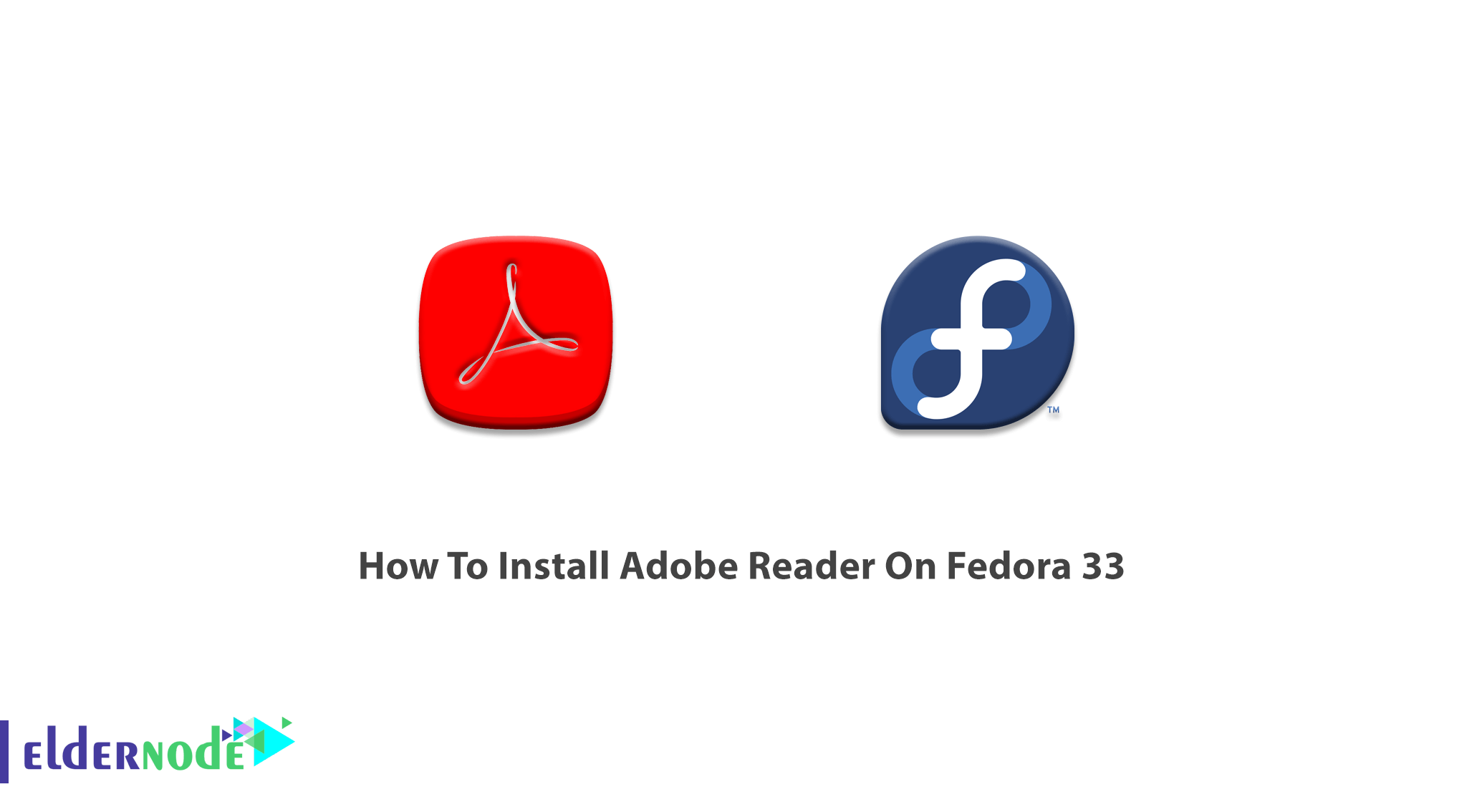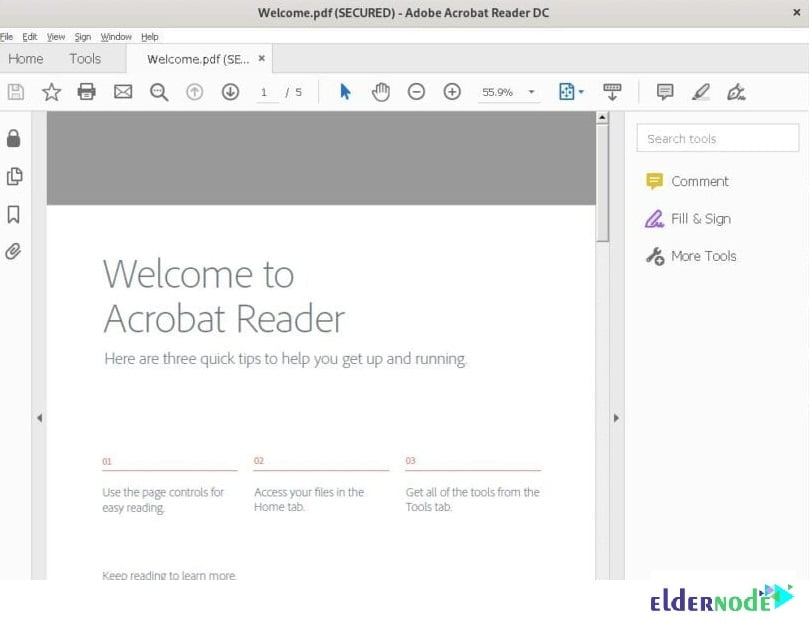
Adobe Acrobat Reader is the most widely use and free software that is using for reliably viewing, printing, and commenting on PDF documents. With this PDF viewer, you can open and interact with all types of PDF content, including for and multimedia. It has designed with a simple user interface that allows users to work in its environment even with the least knowledge. There, you can print PDF files and copy texts and contents inside the file. It comes with two types of installer packages for RPM-based Linux distribution. However, installation depends on the type of installer package. In this article, You will learn How To Install Adobe Reader On Fedora 33. To purchase your own VPS Server, visit available packages on Eldernode to buy what you need.
Table of Contents
Tutorial Install Adobe Reader On Fedora 33 step by step
As you know, Adobe Reader is the most popular software to view Portable Document Format (PDF) documents and you may have used it once till now since it can be installed in almost all kinds of Operating Systems such as Windows, Linux, Mac OS, Android, IOS, and is available in 29 languages. Online document cloud services are provided by Adobe, so you can manage your work from anywhere and from any device. In its premium version, you create PDFs, convert to other formats, edit and protect them. Join us with this article to see the ways you can install Adobe Acrobat Reader on Fedora.
Adobe Reader installation methods on Fedora 33
To install Adobe Reader on Fedora, there are two possible methods:
1- Installing Adobe Acrobat Reader using Snap repository for Fedora. (Easy installing)
2- Installing Adobe Acrobat Reader on Fedora Using Tarball. (Stable installing)
This guide will explain both methods. Stay with us to learn and finish it.
How to enable snaps on Fedora 33 and install Adobe Reader
First, we start with the first and easiest way of installing Adobe Acrobat Reader. As you have read in previous articles, snaps are applications packaged with all their dependencies to run on all popular Linux distributions. Let’s go through the required steps of the first method.
Step 1:
Open a terminal (Alt+Ctrl+T) to install snap on Fedora by running the command below:
sudo dnf install snapdStep 2:
To avoid receiving an error, log out and log in again or restart the system. It lets you confirm if snap’s path is updated or not. Otherwise, you would face an error like the below:
error: too early for operation, device not yet seeded or device model not acknowledged
Step 3:
To enable classic support you need to create a symbolic link.
ln -s /var/lib/snapd/snap /snapStep 4:
In this step, you are ready to install AdobReader since the snap installed. So, run:
snap install acrordrdcBe patient and wait for various files (snapd, core18, etc) to download (The downloaded data will be located at the bottom left side of the System monitor)
To let the process complete. Open System monitor on your Fedora OS and go to the Resources tab.
Step 5:
To start Adobe Acrobat Reader, run the following command:
acrordrdcSince various files for wine like winetricks and others will initialize and download, wait till the end of this proceeding.
Note: You will be asked for the language during the installation process. Select your preferred language and click install to see it will start downloading.
Step 6:
To prevent attacks from sandboxing application processes, you will be asked to open Adobe Reader in protected mode or not. So, help the Adobe Reader to run with your system configuration smoothly and select ”Always Open with Protected Mode Disabled”. Then click OK to launch the Adobe Reader main window. Also, accept the Adobe Reader Distribution License Agreement.
Step 7:
In this step, you can check if a PDF file could be opened with installed Adobe Reader or not. To do this, go to the File menu at the top of the bar and hot Open in the submenu. Then, select the ‘Welcome.pdf’ file.
If you have reviewed all the steps carefully, you should view a window below that says the file is successfully opened.

How to uninstall Adobe Reader from Fedora 33
You can uninstall Adobe Acrobat Reader from the snap repository any tie you wish. Run the following command to do this.
snap remove acrordrdcHow to install Adobe Reader on Fedora 33 using Tarball
As we mentioned, there are two methods to install Adobe Reader on Fedora. Using this method allows you to browse local files easily. But it is not easy after installing by method 1 because you will be confined inside the Wine environment.
This installation requires 136 MB of free disk space. Let’s see how the second method uses Tarball to install Adobe Reader.
Step 1:
First, use the command below to download the tar file of Adobe Reader.
wget ftp://ftp.adobe.com/pub/adobe/reader/unix/9.x/9.5.5/enu/AdbeRdr9.5.5-1_i486linux_enu.tar.bz2Step 2:
Run the tar command to extract this file.
tar -xf AdbeRdr9.5.5-1_i486linux_enu.tar.bz2Step 3:
Then, enter the extracted folder with the command:
cd AdobeReaderStep 4:
While you are inside the extracted folder, use the following install script and install Adobe Reader.
./INSTALLsudo ./INSTALLIn this way, texts will print on the terminal and ask you to enter the installation directory. Choose the default (/opt) or enter a new one. If you press enter key, you can select the default directory. Adobe Reader will be installed when the script is finished. You are ready to configure the installation process in the next step and launch the Adobe Reader.
Step 5:
To launch Adobe Reader, run the following command:
/opt/Adobe/Reader9/bin/acroreadvNote: If you were earlier logged in as root (#) or using the Sudo keyword, you will need to come to the normal user account and remove the ‘sudo’ from the above command. If you continue to use the root account or ‘Sudo’, you will get the below error:
Adobe Reader does not need to be run as a privileged user. Please remove ‘Sudo’ from the beginning of the command.
Also, you may face errors while running the above command (Step 5). So, you need to install some packages from the command below to help you remove these errors.
sudo dnf install libgdk_pixbuf_xlib-2.0.so.0 libxml2.so.2 https://download-ib01.fedoraproject.org/pub/fedora/linux/updates/33/Everything/x86_64/Packages/g/gtk2-2.24.33-1.fc33.i686.rpm -yAgain, run the following command when all the dependencies are installed.
/opt/Adobe/Reader9/bin/acroreadStep 6:
In the following, it will ask you to select the language of installation and to accept the Adobe License agreement. So, accept it to launch the Adobe Acrobat Reader. Start using Adobe Reader and open any file you wish from the ‘File’ menu at the top bar.
Conclusion
In this article, you learned How To Install Adobe Reader On Fedora 33. You reviewed two methods of installation and you should choose between an easy and stable installing. Discuss with your friends on Eldernode Community about these two methods and their Pros and cons.




